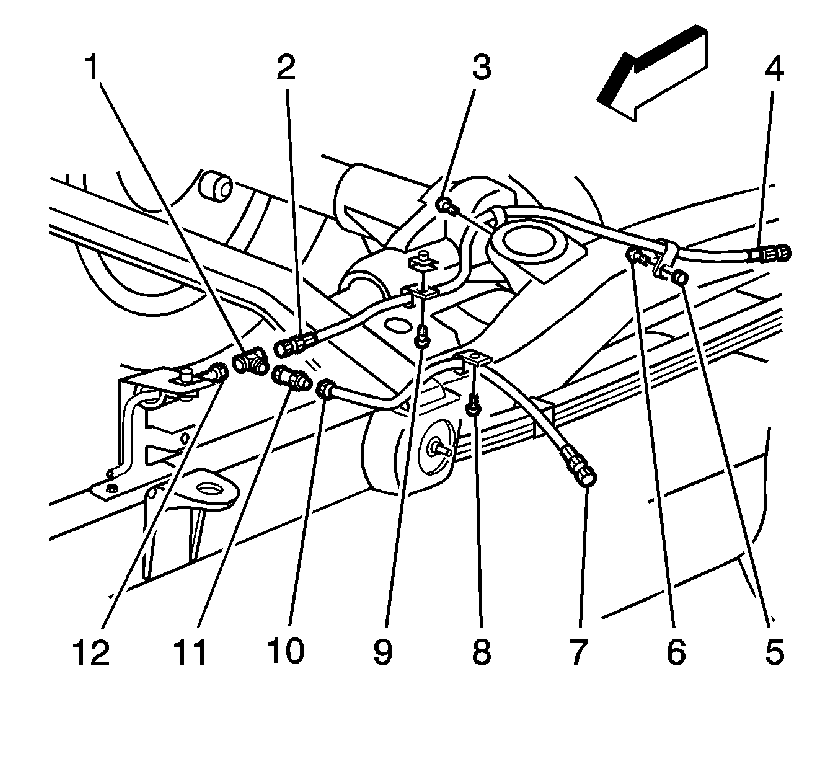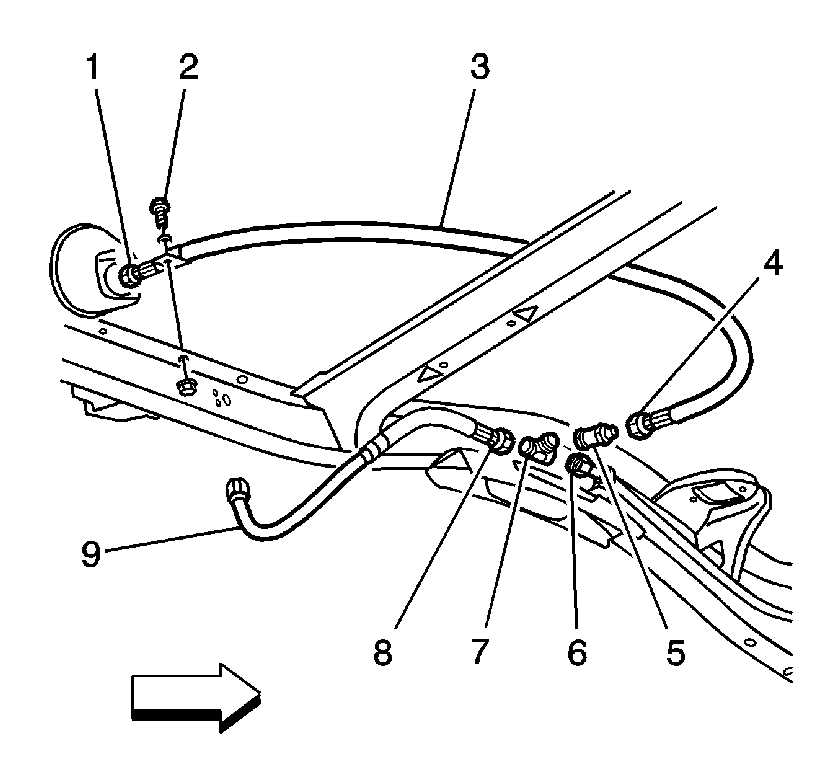Fill Line Union (Check Valve) Replacement Passenger/Cargo
Tools Required
J 45878 Combustible Gas Detector
Removal Procedure
- Relieve the CNG fuel system pressure. Refer to Fuel Pressure Relief .
- Disconnect the negative battery cable. Refer to Battery Negative Cable Disconnection and Connection in Engine Electrical in the G/H Van service manual.
- Raise the vehicle. Refer to Lifting and Jacking the Vehicle in General Information in the G/H Van service manual.
- Disconnect the fill line fitting (10) at the check valve (11) and discard the O-ring.
- Remove the check valve (11) from the tee fitting (1) and discard the O-ring.
Caution: Natural gas is highly flammable. In order to reduce the risk of fire and personal injury, keep sparks, flames, and smoking materials away from the vehicle while you perform the Compressed Natural Gas (CNG) fuel system service.
Caution: The Compressed Natural Gas (CNG) system operates at pressures up to 24820 kpa (3600 psi). Relieve the CNG fuel system pressure before servicing CNG fuel system components in order to reduce the risk of fire and personal injury.

Installation Procedure
- Install the check valve (11) to the tee fitting (1) using a NEW O-ring. Lubricate the new O-ring with petroleum jelly or equivalent before installation.
- Connect the fill line fitting (10) to the check valve (11) using a NEW O-ring. Lubricate the new O-ring with petroleum jelly or equivalent before installation.
- Install the negative battery cable. Refer to Battery Negative Cable Disconnection and Connection in Engine Electrical in the G/H Van service manual.
- Start the vehicle and inspect for CNG fuel leaks at the serviced fittings with the J 45878 or an equivalent leak detector.
Notice: Refer to Fastener Notice in the Preface section.

Tighten
Tighten the check valve to 45 N·m (33 lb ft).
Tighten
Tighten the fuel line fitting to 45 N·m (33 lb ft).
Fill Line Union (Check Valve) Replacement Cutaway
Tools Required
J 45878 Combustible Gas Detector
Removal Procedure
- Relieve the CNG fuel system pressure. Refer to Fuel Pressure Relief .
- Disconnect the negative battery cable. Refer to Battery Negative Cable Disconnection and Connection in Engine Electrical in the G/H Van service manual.
- Raise the vehicle. Refer to Lifting and Jacking the Vehicle in General Information in the G/H Van service manual.
- Disconnect the fuel line fitting (4) at the check valve (5) and discard the O-ring.
- Remove the check valve (5) from the tee fitting (7) and discard the O-ring.
Caution: Natural gas is highly flammable. In order to reduce the risk of fire and personal injury, keep sparks, flames, and smoking materials away from the vehicle while you perform the Compressed Natural Gas (CNG) fuel system service.
Caution: The Compressed Natural Gas (CNG) system operates at pressures up to 24820 kpa (3600 psi). Relieve the CNG fuel system pressure before servicing CNG fuel system components in order to reduce the risk of fire and personal injury.

Installation Procedure
- Install the check valve (5) to the tee fitting (7) using a NEW O-ring. Lubricate the new O-ring with petroleum jelly or equivalent before installation.
- Connect the fill line fitting (4) to the check valve (5) using a NEW O-ring. Lubricate the new O-ring with petroleum jelly or equivalent before installation.
- Install the negative battery cable. Refer to Battery Negative Cable Disconnection and Connection in Engine Electrical in the G/H Van service manual.
- Start the vehicle and inspect for CNG fuel leaks at the serviced fittings with the J 45878 or an equivalent leak detector.
Notice: Refer to Fastener Notice in the Preface section.

Tighten
Tighten the fill line fitting to 45 N·m (33 lb ft).
Tighten
Tighten the fuel line fitting to 45 N·m (33 lb ft).
